Of all the things associated with modern suburban life, few are as iconic as a lush, green lawn. We know a lawn to be a flat, usually level area of cultivated and mown grass, and while many people love a lawn, there are some great alternatives if you're not one of those people.
There are many reasons why you might want a lawn, and many reasons why you may be looking to do away with your lawn. Come along with us to find out how lawns came about in the first place, why you might still want or need a lawn, and what the alternatives are if you're looking to make a change away from having a lawn.
What is a Lawn and How Did They Come About
The earliest lawns are thought to have appeared in the middle of the 16th century. They differed pretty significantly from their modern counterparts, and were simply fenced-off areas used to pasture livestock. These grassy areas were grazed regularly over long periods of time and formed a short, tight sward that resembles what we know nowadays as a lawn.
It was these 'lawns' that came to be valued by people, especially the aristocracy, as it meant they could more easily see who was approaching their land. In the 17th and 18th centuries, gardens and lawns became places where people could walk and socialise, and were often made up of meadow plants other than grass, such as chamomile.
Lawns were initially a feature only in Western Europe, where the climate was suitable for their growth and maintenance, however, the concept slowly spread throughout the rest of Europe. The concept of a lawn then spread to North America and the rest of the developed world, including Australia.
It’s important to note that the lawns of the time required incredible amounts of labour to maintain, as they had to be manually cut using scythes or shears. This led to them being associated with wealth and status as only the richest and most successful landowners could afford to pay for their upkeep.
When the first lawn mowing machines were developed in the early part of the 19th century, they changed the game entirely. By reducing the costs associated with lawn maintenance, lawns were quickly brought within the grasp of middle-class homeowners, and by the end of the 1920s, grassy lawns had become commonplace and were the ground cover of choice for homeowners for the next 50 years or so.
Reasons for Having a Lawn
There are many reasons why people want to install and maintain lawns. Some of the most common reasons include:
- Many people grew up with lawns, so they like them for nostalgic reasons.
- Lawns are usually quite comfortable surfaces, making them great for leisure and recreation.
- They can be a safe and welcoming place where children and pets can play.
- Many lawns are durable and tolerate large amounts of foot traffic.
- Lawns can often serve decorative purposes or be incorporated into larger garden and landscape designs.
- Many homeowners believe that lawns will help increase the value of their house and yard.
- Some people still consider lawns to be a sign of wealth.
Additionally, some people have a lawn because it is the default choice; they simply never considered not having a lawn. Nevertheless, a growing number of people are considering moving on from lawns and replacing them with alternatives.
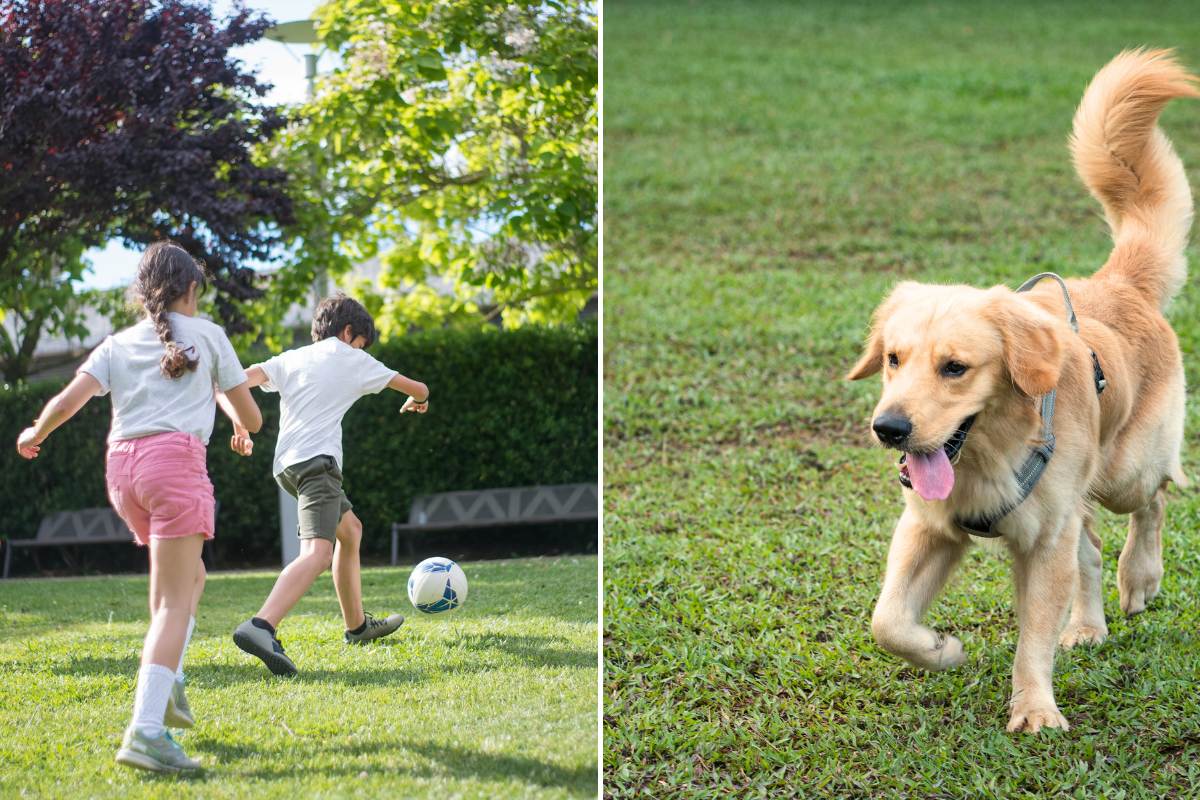 A place for children and pets to play is still a good reason to keep and maintain a lawn.
A place for children and pets to play is still a good reason to keep and maintain a lawn.
Thinking About Doing Away With Your Lawn? Consider These Things First
Lawns certainly require a great deal of maintenance and care, and can also be expensive and labour-intensive to install. Accordingly, they should only be replaced after careful thought and deliberation because reinstalling a lawn is neither cheap nor easy.
If you do decide to do away with your lawn, you’ll want to ask yourself several questions before heading down the lawn-free path.
1. Why do you want to get rid of the lawn?
Just as there are several reasons people like having a lawn, there are also a variety of reasons people want to remove them. It is important to examine your reasons before making the switch as some lawn alternatives present the same drawbacks that lawns do, which could leave you no better than you were before.
Some of the most common reasons people decide to get rid of a lawn include:
- They don’t want to spend the time mowing their lawn and dealing with the clippings every week or two.
- They want to avoid the myriad costs associated with lawn maintenance, including the upkeep of a lawn mower, edge trimmer or leaf blower.
- The lawn area is small and just plain annoying to mow and look after.
- Because of limited sun exposure, grass doesn’t grow well on their property.
- They find that garden beds or other landscaping features are more attractive.
- They want to use the space to grow food or ornamental plants.
- They aren't comfortable with the amount of fresh water required to keep a lawn healthy, or the environmental impact of stripping a site to install a lawn.
- They want to replace their lawn with something that’s beneficial to wildlife.
All of these are valid reasons for removing and replacing a lawn. However, it is important to consider the flip side of these reasons. For example, while you may not have to mow the area after removing your lawn, the new plants or landscape features will still require some maintenance.
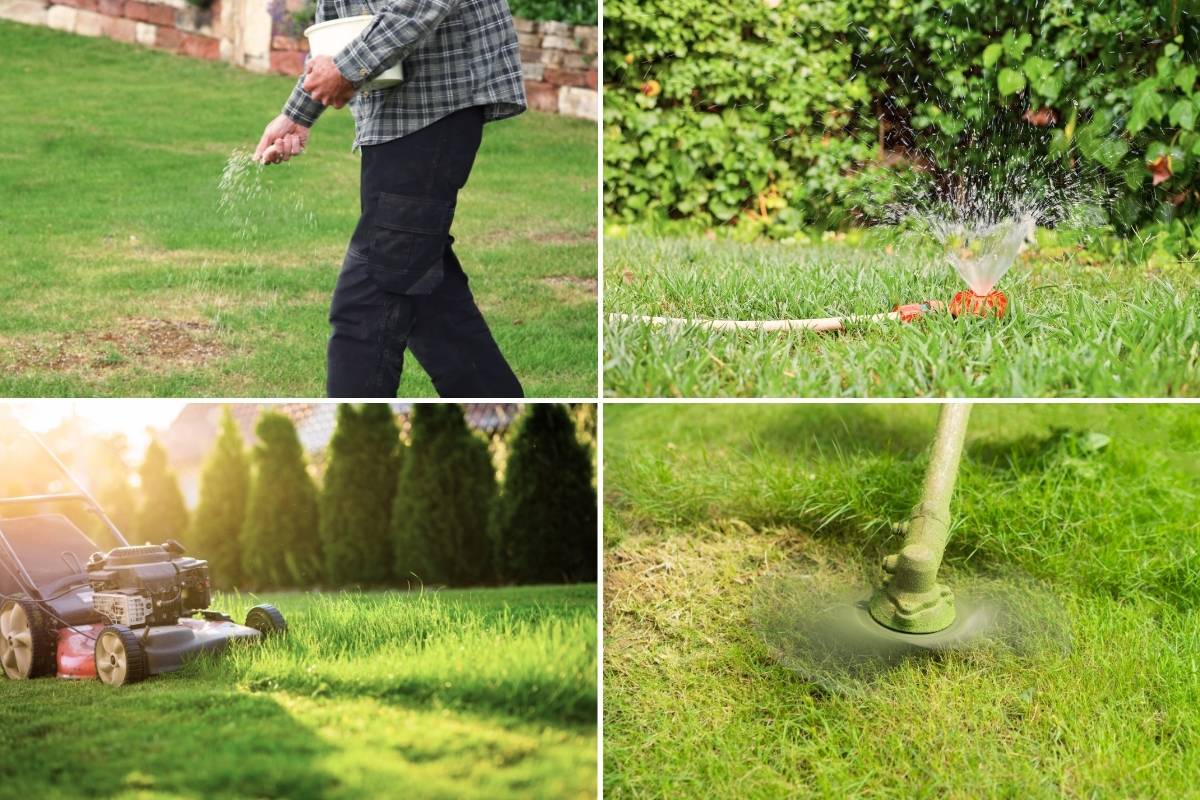 Ongoing lawn care can be a reason to decide to remove a lawn and replace it with something else.
Ongoing lawn care can be a reason to decide to remove a lawn and replace it with something else.
2. Do you still want something green where the lawn was?
Deciding to remove your lawn is one thing; deciding what to replace it with is another. You’ll almost always need to put something there and while most people probably default to other plants, you can also opt for a variety of non-living alternatives that may be just as aesthetically pleasing.
3. What will the foot traffic be like in the area?
Foot traffic is a critical consideration for all landscape plans. Will the foot traffic be high or low, i.e., will the area be frequently or only occasionally walked on or used? In most cases you’ll need to select a groundcover or surface treatment that can withstand the impact of people and pets.
Most plants simply won’t thrive if tread upon routinely, and this is part of the reason that lawns are so popular in many areas. However, there are a few plants that will tolerate a bit of foot traffic (once well established) that you can consider.
4. What are the potential maintenance requirements of lawn alternatives?
Often, replacing a lawn with some other type of surface or ground cover will reduce the overall maintenance required, but that doesn’t mean you won’t have to conduct any maintenance either.
For example, mulches and other lightweight ground covers may tend to drift away from the area in which they’re placed. This means you’ll have to break out the broom or rake periodically to keep the area looking tidy. Heavy foot traffic will also accelerate the rate at which a wood chip mulch breaks down, and people constantly walking over it will cause it to scatter more quickly, potentially causing cleanup headaches and making the area appear unkempt.
Bricks, stone pavers, and similar alternative surfaces may accumulate dirt, dust and fallen leaves and will require periodic sweeping and cleaning to keep them looking good. Moss or algae could also become an issue in shaded areas which will need to be removed at least on an annual basis to prevent the surface from becoming a hazard, but this may be preferable to having to mow a lawn every few weeks.
5. Could garden beds instead of a lawn be the answer?
If you don't need to have a lawn for children or pets to play on, then consider creating a garden consisting of meandering paths between large garden beds. In this way you can create a pleasant, lower maintenance garden you can stroll about in, which in turn gives you the opportunity to create more habitat for a wildlife-friendly garden.
Lawn Alternatives
If, after careful consideration, you’ve decided that your lawn can go, you can begin thinking about what you’ll put in its place.
There are several possible alternatives to a traditional grass lawn, including living and non-living options. We’ll tackle these individually, as they involve very different considerations.
1. Living lawn alternatives
Living lawn alternatives are non-grass options that still give the same 'green carpet' look that you get from a traditional grass lawn.
The most important things to take into account when choosing a living alternative are the amount of foot traffic and whether or not the area is in a sunny or shady spot. Both of these things are critical to the success of your living lawn alternative as you don't want to choose something sensitive and have it trampled to death in no time at all, and nor do you want to plant something that is perhaps more suited to a shady spot in the full sun.
There are many non-grass alternatives that you can use, but here are some of the more well-known, tried and trusted plants that you might like to try:
Dichondra (Dichondra repens) is a perennial evergreen groundcover that grows to about 10cm in height, and each plant can spread to about 2m. It grows best in partially shaded areas, and while it won't tolerate high amounts of foot traffic, it is an excellent choice for low-traffic areas.
Pennyroyal (Mentha pulegium) is one of the best smelling ground covers available, giving off a lovely minty aroma when you walk on it. Suited to sunny or dappled shade areas it produces spikes of lavender flowers in summer. It may require light mowing, especially to remove spent flower spikes, but in addition to being attractive, it often repels some troubling insects while attracting beneficial species.
.jpg) Dichondra (top) does well in partially shaded areas and also looks great combine with pavers; Pennyroyal (bottom) provides a minty fragrance when you walk on it and flowers are attractive to beneficial insects.
Dichondra (top) does well in partially shaded areas and also looks great combine with pavers; Pennyroyal (bottom) provides a minty fragrance when you walk on it and flowers are attractive to beneficial insects.
Creeping Thyme (Thymus serpyllum) is a low-growing herb with a spreading growth habit that requires relatively little maintenance once established. It's a great choice for sunny areas and areas with poor soil, and creeping thyme can also survive drought conditions, making it a very environmentally friendly option.
Lawn Chamomile (Chamaemelum nobile) is a well-known and popular lawn replacement. It grows up to 20cm in height, has fern-like foliage and pretty white daisy flowers. While it grows best in full sun, harsh afternoon sunshine can stress it, so it works best in places with afternoon shade.
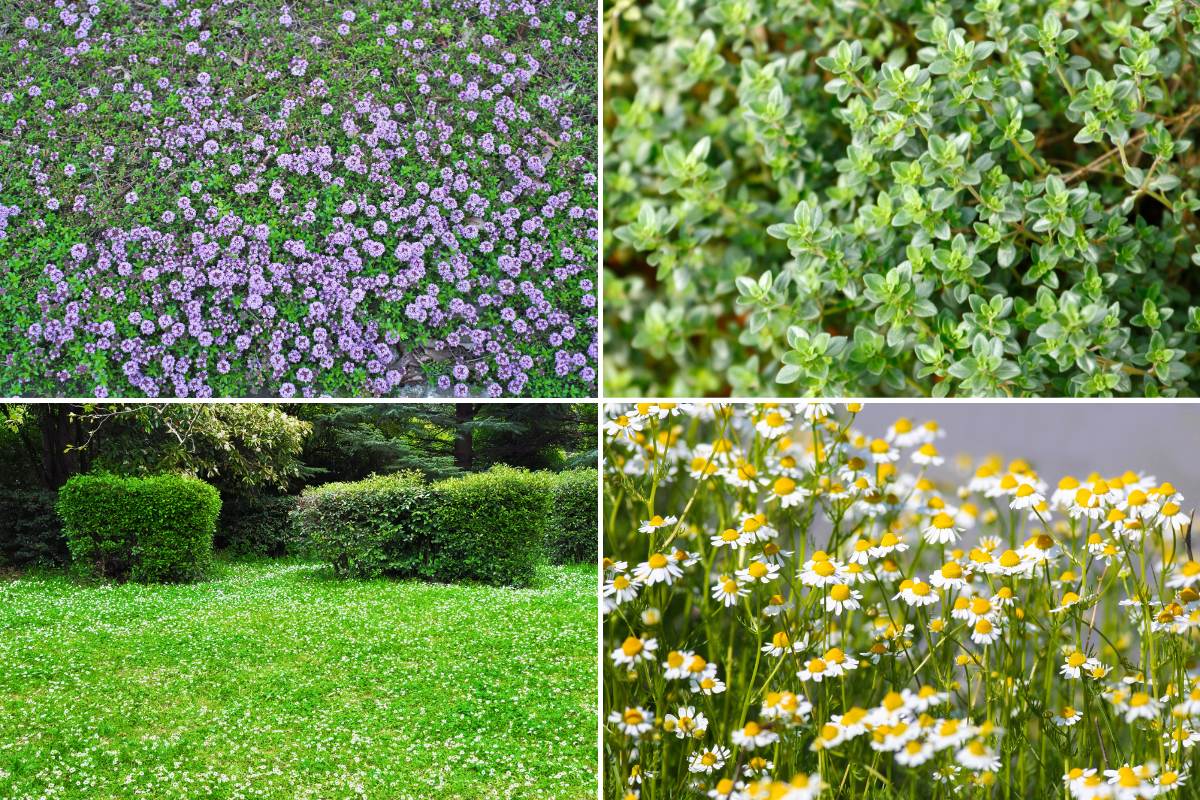 Creeping Thyme (top) and Lawn Chamomile (bottom) are great alternatives for sunny areas.
Creeping Thyme (top) and Lawn Chamomile (bottom) are great alternatives for sunny areas.
2. Non-Living Lawn Alternatives
There is also a place for non-living lawn alternatives and while most are usually brown or grey in colour, they can often work exceptionally well in a garden design. Remember the overall brown or grey look can always be toned down by planting around the edges, or in the case of pavers, plants such as Dichondra or creeping thyme can be planted in between them.
Gravel and sand areas can look good, and works well especially in dry areas. They have the advantage of being durable and are good options in fire-prone regions as they're not flammable. You may not like the idea of having sand or gravel immediately adjacent to your house in case it gets tracked into the house, but this isn't a problem if you have a verandah or porch, and if not, it can easily remedied by placing a few pavers between your house and sand/gravel area. The only other possible downside to gravel and sand is that it can become quite hot when exposed to strong sunlight, but this is mainly only a problem if you like walking outside in bare feet.
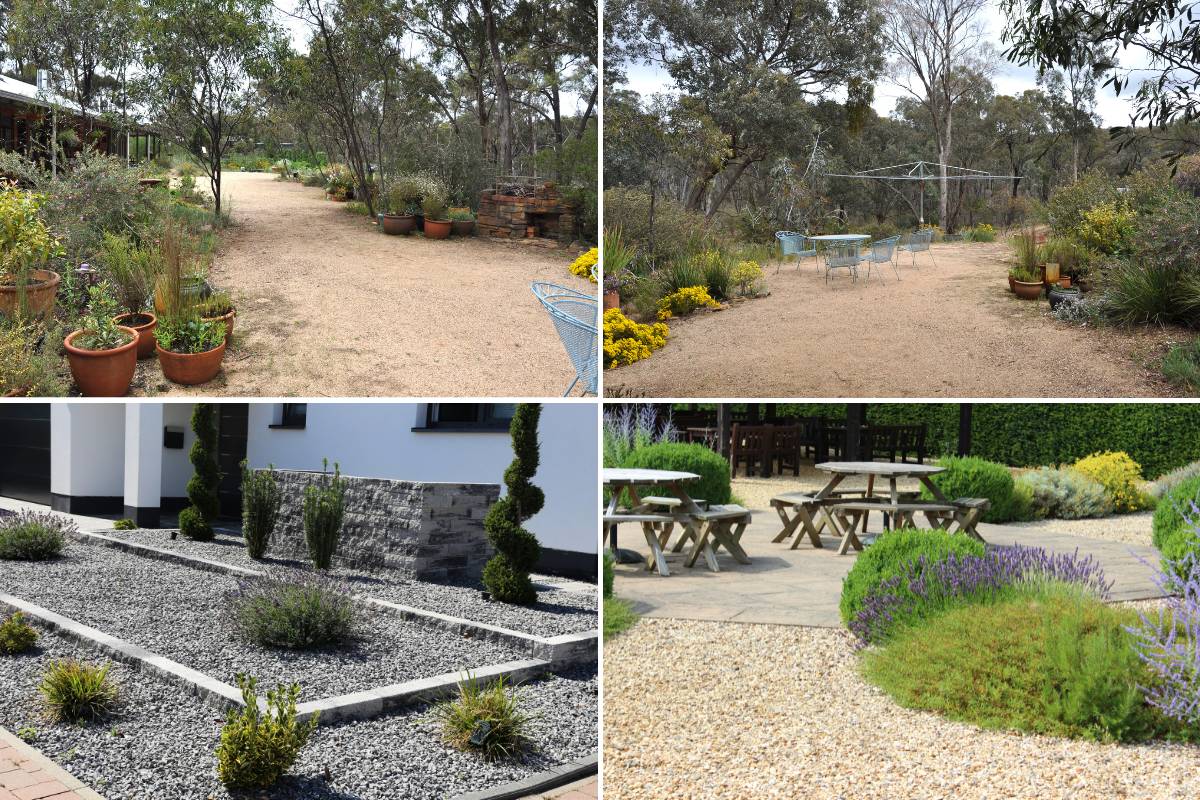 Sand (top) is an excellent non-flammable lawn replacement lawn in a bushfire-prone garden; Gravel (bottom) comes in many colours and can be used to great effect in garden design instead of traditional grass lawn.
Sand (top) is an excellent non-flammable lawn replacement lawn in a bushfire-prone garden; Gravel (bottom) comes in many colours and can be used to great effect in garden design instead of traditional grass lawn.
Organic mulch is light and easy to transport, environmentally friendly, relatively cheap, and can be an attractive non-living ground cover. Additionally, mulched areas can be beneficial to soil microorganisms, as well as nearby tree roots, as they not only help retain moisture but can prevent competing plants from growing in the area. However, some mulches can feel sharp to bare feet and most types are flammable, which can present a fire hazard in dry areas, so consider if this is the right option for you.
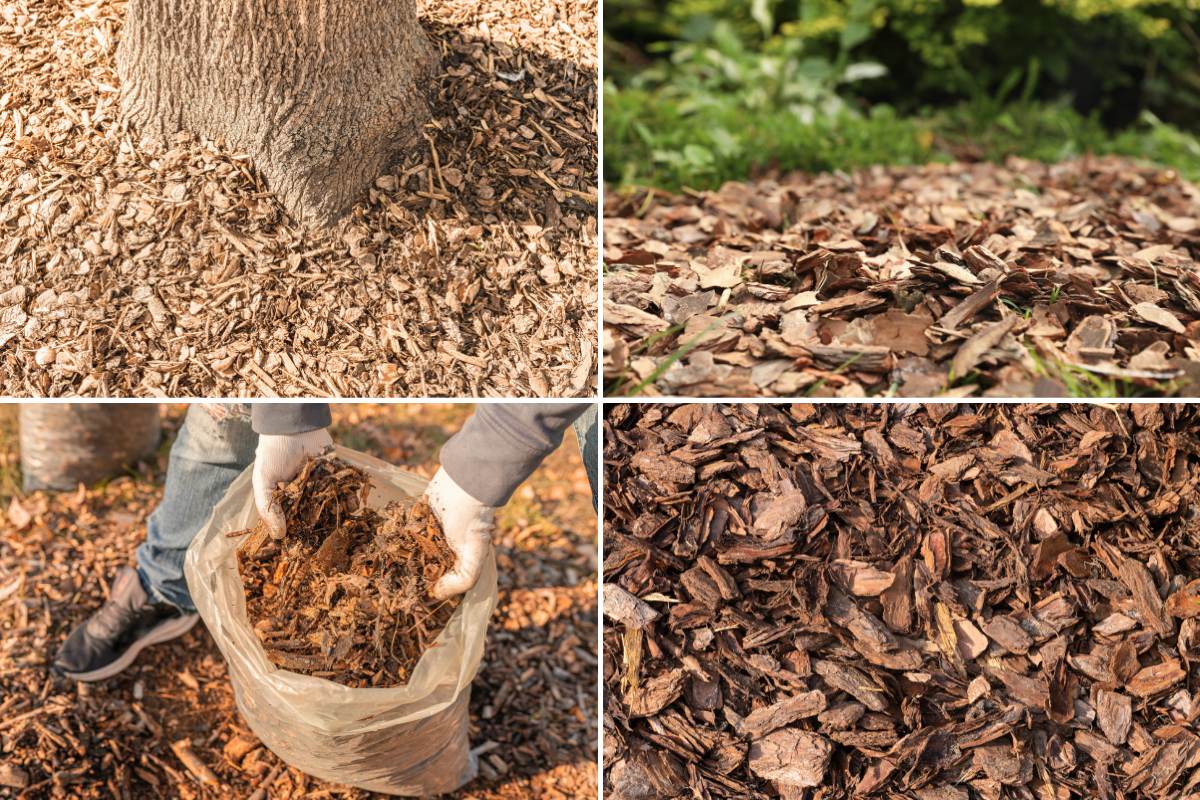 Organic mulch is lightweight and can encourage beneficial soil organisms.
Organic mulch is lightweight and can encourage beneficial soil organisms.
Bricks and pavers are attractive, and are also a safe option to use in fire-prone regions. They can however be too expensive for homeowners who need to cover large areas. One of the downsides to bricks and pavers is that weeds can sprout in the cracks between them, but they are still a relatively low-maintenance and long-lasting option. If the space between your pavers is large enough, then you could always plant a low-growing groundcover between them which will help suppress weeds.
.jpg) Bricks and pavers work well in places that are difficult to mow or don't get enough sunlight. Weeds can be a problem but are easily taken care of.
Bricks and pavers work well in places that are difficult to mow or don't get enough sunlight. Weeds can be a problem but are easily taken care of.
Some people view synthetic grass or turf as a maintenance-free lawn alternative, but while you may not need to water or mow it, it does still require maintenance. You will need to rake or sweep leaves and other debris off the surface, and give it a good wash down occasionally to remove dirt and dust that builds up amongst the fibres. It may also need weeding as windblown seeds can settle between the fibres and start to germinate. Being a plastic product also means that over time it may start showing signs of wear and discolouration as it starts breaking down in the sunlight, and as it can’t be recycled or composted, when it needs replacing it needs to be disposed of in landfill.
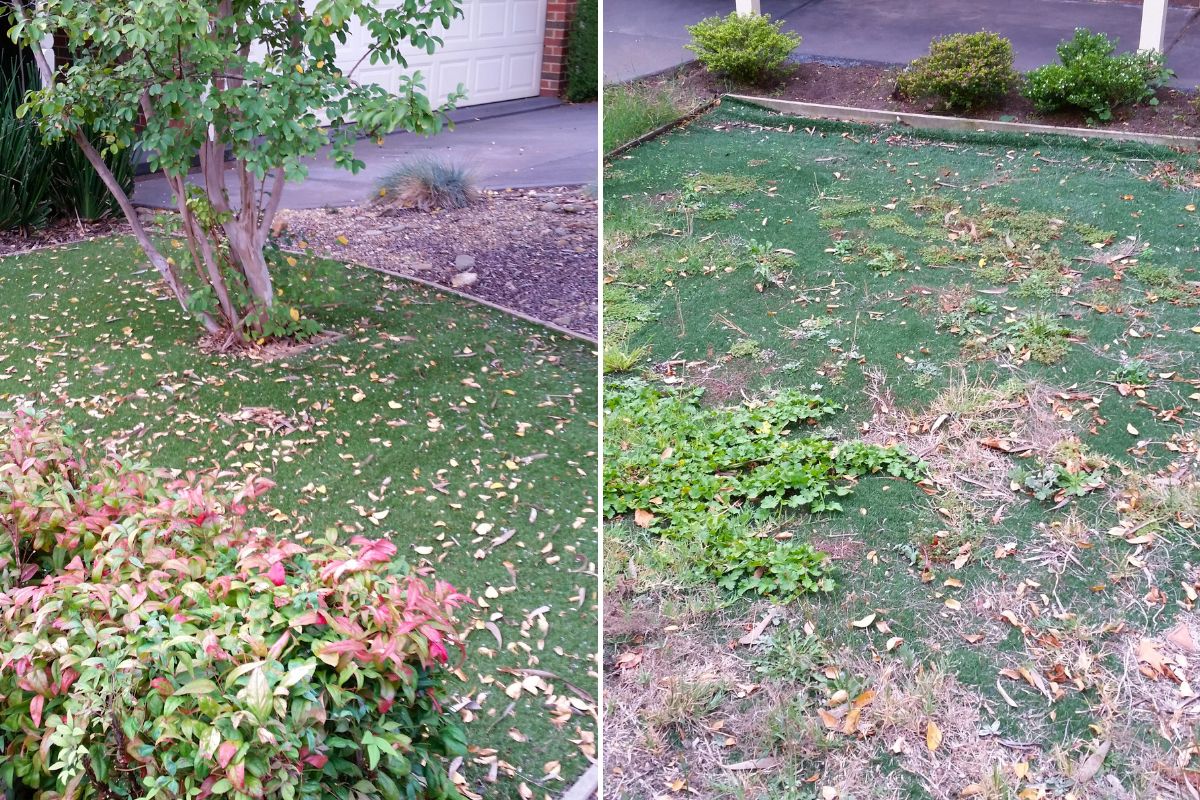 Modern synthetic turf can look very realistic but still needs some maintenance from time to time as sand and dirt collecting amongst the fibres provides a foothold for weed seeds to germinate.
Modern synthetic turf can look very realistic but still needs some maintenance from time to time as sand and dirt collecting amongst the fibres provides a foothold for weed seeds to germinate.
***
As you can see, having a traditional grass lawn is not the only option available these days, especially as properties get smaller and the available space for a lawn decreases. Some of the non-living alternatives can even enhance modern house designs, and if you prefer a more rustic or relaxed look, then one of the living lawn alternatives may be exactly what you are looking for, with the added benefit of bringing more wildlife into your garden.
A traditional grass lawn can however still look good and they do offer several key benefits, such as their ability to tolerate significant foot traffic as being a place for children and pets to play. However, if for you, the downsides of a lawn, like the need to water and maintain it regularly, outweigh the benefits they provide, then we hope some of these alternatives give you some great ideas that you might like to try in your own backyard.





